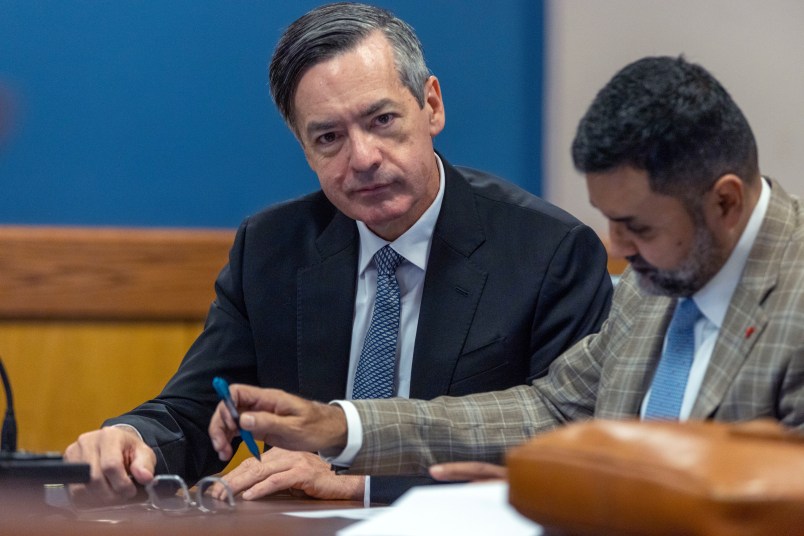Ken Chesebro pleaded guilty this morning in Georgia and has agreed to cooperate in Fulton County. A close look at Jack Smith’s January 6 indictment of Donald Trump sheds more light on what the Trump campaign lawyer may know about the 2020 coup attempt and what he could reveal to prosecutors in Georgia.
Chesebro admitted on Friday that he plotted to have a group of Georgia GOP officials “falsely hold themselves out” as electors for Trump, even though the former President lost the state. That included, Chesebro admitted, the creation of fake electoral college documents as part of a “multi-state conspiracy” to keep Trump in power after he lost the 2020 election.
It’s a significant admission for Chesebro: as an architect of the fake electors scheme, he long maintained, including in a lengthy interview last year to TPM, that the presence of a controversy over the election was enough to justify creating slates of “alternate” electors to preserve Trump’s chance at victory long after any reasonable hope had been extinguished.
Now, Chesebro has formally admitted that it was at least, partly, a sham — he pleaded guilty to one count of conspiracy to commit false statements related to his efforts to theorize and organize fake slates of electors.
Per a review of Smith’s January 6 indictment of Trump, Chesebro could have a lot to say in Fulton County about Rudy Giuliani and the mysterious “co-conspirator 6.” The New York Times reported that that likely referred to Boris Epshteyn, a Trump attorney. Neither Giuliani nor Epshteyn have been charged with any wrongdoing. Chesebro has also not been charged federally with any crime.
Chesebro does not appear by name in Smith’s Jan. 6 indictment. Rather, a lawyer dubbed “co-conspirator 5” matches Chesebro’s description as an “attorney who assisted in devising and attempting to implement a plan to submit fraudulent slates of presidential electors to obstruct the certification proceeding.”
Smith portrayed “co-conspirator 5,” Chesebro, as working closely with “co-conspirator 1,” identified publicly as Rudy Giuliani.
In the days before the fake electors cast their ballots, Smith alleges that Giuliani directed Chesebro to organize the creation of the fake elector slates. That included Giuliani, on Dec. 10, 2020, allegedly having Chesebro send “instructions” to fake electors in several states.
Chesebro admitted in Fulton County Superior Court on Friday that the documents he sent to the fake electors were part of a conspiracy to induce them to “falsely hold themselves out” as the legitimate presidential electors. That, per the Willis indictment, included the instructions memos.
There’s another moment in the Smith indictment, as well, which goes directly to Chesebro’s attempt to create a controversy which could serve as a pretext for convening slates of fraudulent electors.
In Arizona, per the Smith indictment, Giuliani allegedly told Chesebro about a conversation he’d had with an unnamed state official where the person said that convening Trump electors in the state would “appear treasonous” absent a “pending court proceeding.”
So, federal prosecutors said, Giuliani directed Chesebro to have an Arizona attorney file a lawsuit before the Supreme Court “as a pretext” to allow fake electors to convene in the state.
Per the plea agreement with Willis’ office, Chesebro admitted that, in the case of Georgia, it was false to state that Trump “won all of [the state]’s electoral college votes.”
“Co-conspirator 6” (whom the Times identified as Epshteyn) also appears throughout the Chesebro section of the Smith January 6 indictment.
At one point, Chesebro allegedly drew on a list of attorneys which “co-conspirator 6” had assembled. On Dec. 12, Giuliani, Chesebro, and “co-conspirator 6” allegedly spoke with fake electors over a conference call, in which Giuliani “falsely assured them that their certificates would be used only if the Defendant succeeded in litigation.”
The extent to which Chesebro could implicate Trump is far less clear from the structure of the Smith indictment. The former President is charged in Fulton County with the same crime to which Chesebro pleaded guilty in Georgia. But that doesn’t necessarily mean that Chesebro will be able to tell prosecutors about Trump. Per the Smith indictment, Trump’s involvement in the fake electors plot mainly took place apart from Chesebro and via Giuliani.
Smith, however, omitted Chesebro from the description of how the fake electors “convened sham proceedings” the day of to declare themselves electors.
There, it’s only two people: Giuliani and Trump.
An attorney for Chesebro tried to downplay his usefulness after the plea hearing, telling reporters that he didn’t think Trump had any reason to worry at all.



